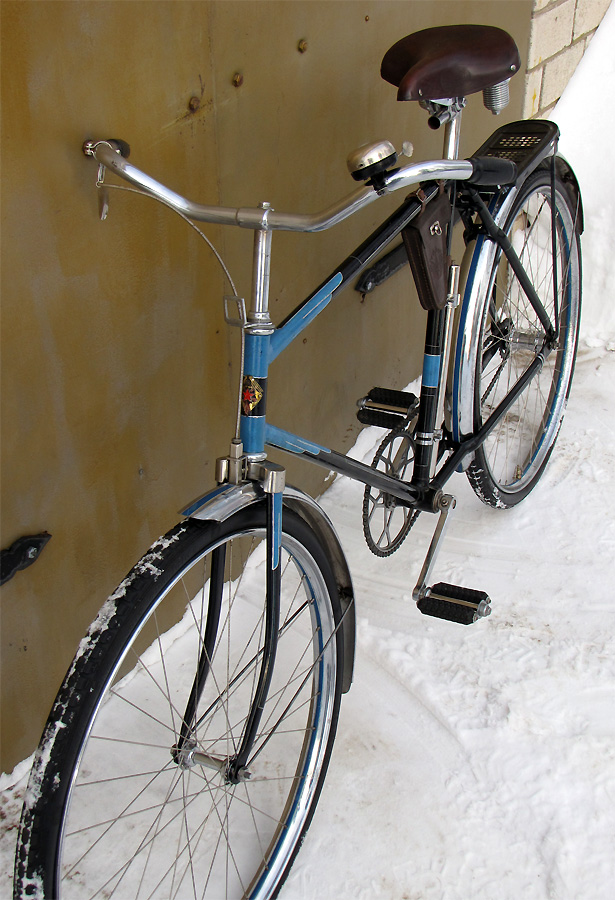Bicycle during the first Soviet period and in World War II
Bicycle import from Sweden and England stopped after annexation of Estonia to the Soviet Union at the onset of World War II (in 1940). Until commencement of military action between the USSR and Germany in June 1941, major local bicycle manufacturers continued to work, the same goes for import of bicycles from Germany. However, the quality of various bike assemblies declined due to the war – e.g. bicycle factory “Säde” (Spark in Estonian) used Centrix-freewheel when assembling bikes instead of Torpedo freewheel. After incorporating Estonia in the Soviet Union in 1940, the goods deficit reached started to affect the purchasers as well – bicycles and parts thereof were no longer as freely available as in pre-war times.
Actual hostilities between the Soviet Union and Germany in June 1941 and quickly moving German front caused Soviet evacuation, which involved commandeering private means of transportation. Although in most cases commandeering concerned cars and motorbikes, there were many places where it also concerned bicycles, particularly by overly eager local activists.
In fear for commandeering and legends surrounding it, many people disassembled their bikes and hid them in the summer of 1941. Many bikes remained that way in the difficult post-war period and preserved as (most of the) parts until today. There were stories about commandeering only men’s bikes (for army purposes), and thus several men hurried to local village workshop to weld their bike’s frame into women’s bike frame to save the bike itself.
German troops arriving to Estonia in July and August 1941 brought along many German military bikes (Truppenrad in German). Namely, German army actively used bicycles in the early years of World War II and in 1939-41 many bike factories, such as NSU, Wanderer, Express, Steyr, etc., made special military bikes by public procurement. Most of the junctions and solutions of military bikes were identical to civil bikes. Main differences consisted in almost matte black colour (with lack of galvanics), easily turned/removed handlebar, unified dimensions (enabled mass transport and spare parts) and year of manufacture on the joint beneath the saddle on the other side of the frame number. Another special feature of German military bike was rack made of steel bars, riveted together (local workshops copied this after the war for practicality reasons).
In Estonian conditions, another indication to military bike consists in wheels intended for wired tyres with steep central groove. Local bikes had no such profile before the war, because here were beaded edges the common tyre standard (however, the same profile was present in post-war German reparation bikes).
Much less common than ordinary German military bike is parachutist (airdrop) bicycle with foldable frame and one turnable pedal – when folded, such bicycle had to fit in the backpack of parachutist.
After the war, there were tons of German military bikes left in Estonia and they were quite common in the streets in the 1940s-50s. Meanwhile, introduction of these bikes by local people in the late 1940s was not entirely legal – officially, entire German military inventory (including bicycles) was in the possession of Soviet Union after the capitulation in 1945 and was thus subject to seizure. Therefore, people removed recognizable handlebars and racks from military bikes and replaced them with relevant parts of regular bike in order to conceal the origin of the bicycle from untrained eye.
There were virtually no bicycles commercially available (for private persons) during the German times, in 1941-44, and their sales required special permit. Small bicycle workshops operated to certain extent. They had some supply of old spare parts and occasionally gained some new ones.
Yet, during this period, the local Self-Defence Force responsible for maintaining public order came into possession of a remarkable batch of service (police) bikes. In many ways, they were similar to military bikes, but had painted, not chromed (and in many cases hot galcanized or oxydised coating), which was actually not arbitrary, but caused by lack of non-ferrous metals during the war.
In order to avoid transfer of service bikes to private use, their front frame was equipped with clearly legible pressed label “Pol. Dienstrad” (police service bicycle in German). Similar to military bikes, the service bikes also had year of manufacture on the other side of the gasket beneath the saddle. Majority of service bicycles brought in Estonia were Baronia.

